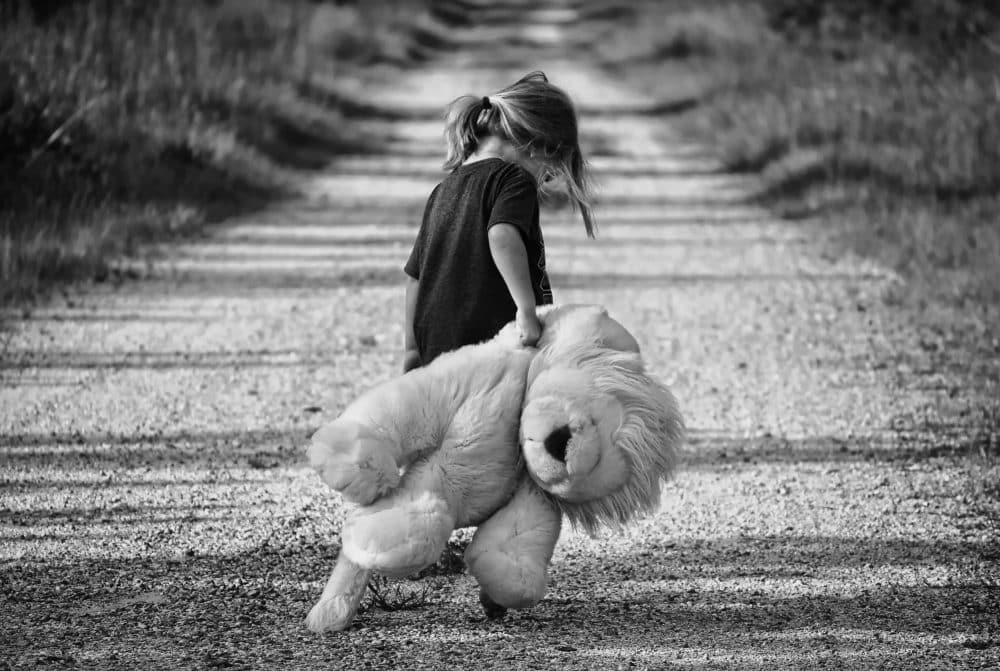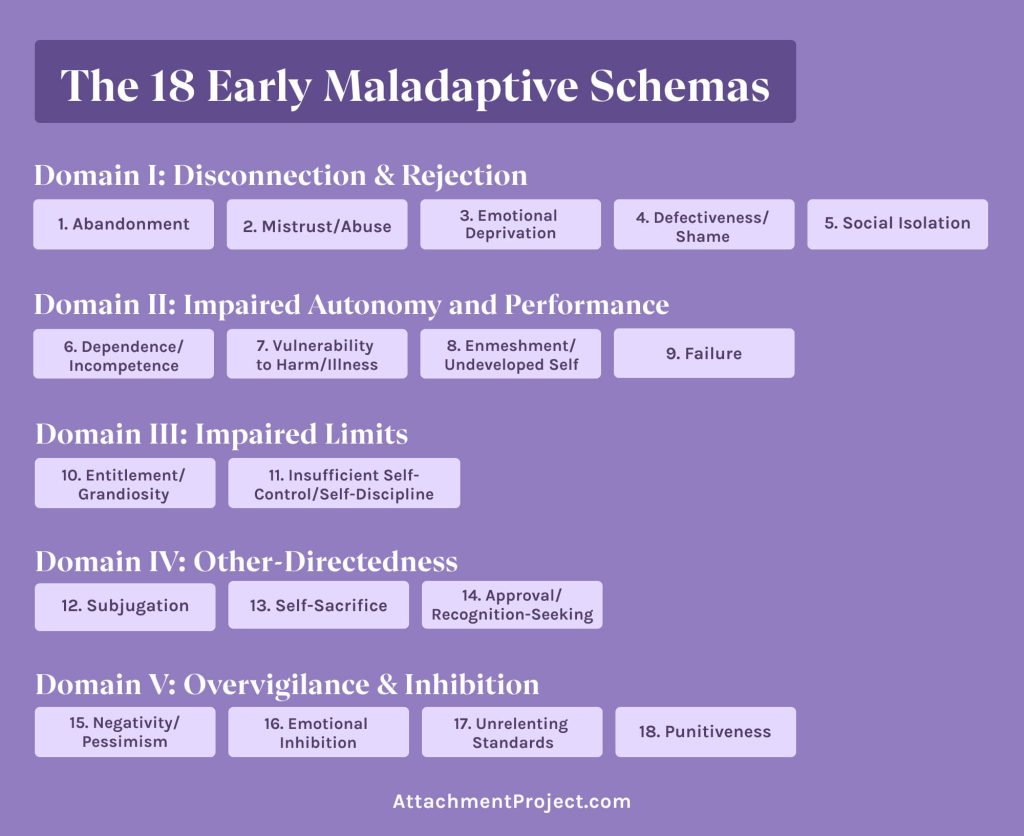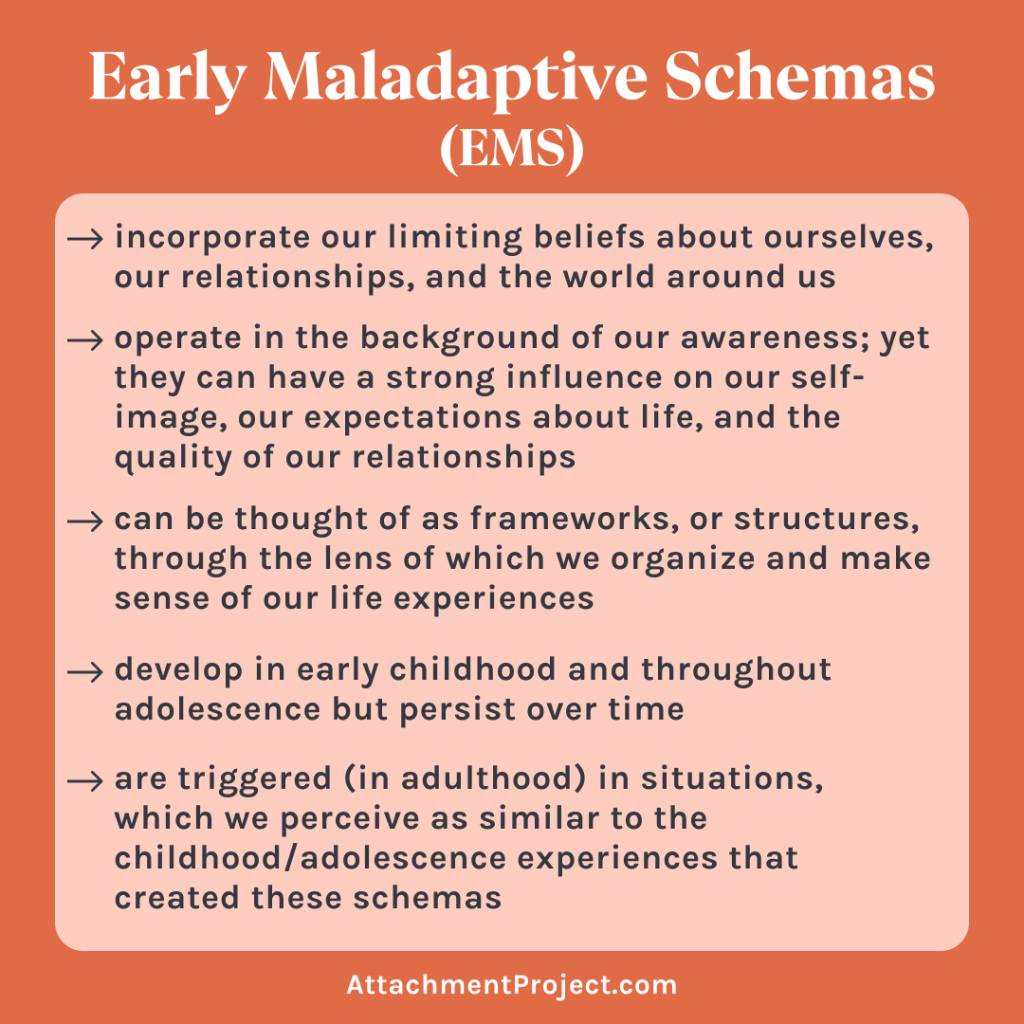The Ultimate Guide to Early Maladaptive Schemas [Full List]

Published on June 11, 2021 Updated on April 10, 2024
In Schema Therapy, there are 18 Early Maladaptive Schemas (EMS), which are divided into five domains:
- Disconnection & Rejection
- Impaired Autonomy & Performance
- Impaired Limits
- Other Directedness
- Over-vigilance & Inhibition
If you’re new to Schema Therapy, we’d advise you to get a quick introduction into the topic before you dive into the specifics of each Early Maladaptive Schema.
After reading this article, you will be able to answer the following questions:
- What are Early Maladaptive Schemas?
- How do we develop a specific schema?
- What are our 5 core emotional needs?
- What are 4 types of experiences that can foster schemas in childhood?
- How does each schema develop in childhood?
- What are the patterns and behaviors of adults with each schema?
- What are the 3 types of emotional deprivation?
- Which schemas are easier/more difficult to heal with therapy?
- Which schemas are commonly seen together?
What is an Early Maladaptive Schema?
Schemas (in general) incorporate our beliefs about ourselves, the world around us, and the world of others.
These beliefs operate in the background of our awareness. However, they have great influence over our sense of self, our expectations about life, and the quality of our relationships.
You can think of schemas as frameworks through the lens of which we organize and make sense of our life experiences.
Schemas are not always negative, or maladaptive. Still, Dr Jeffrey Young places the focus of his model on Early Maladaptive Schemas. From this point on, we are going to use the words schema and Early Maladaptive Schemas interchangeably.
Let’s start with the original definition from the book “Schema Therapy: A Practitioner’s Guide.” According to Young, Klosko, and Weishaar (2003):
An Early Maladaptive Schema is:
- “a broad, pervasive theme or pattern
- comprised of memories, emotions, cognitions, and bodily sensations
- regarding oneself and one’s relationships with others
- developed during childhood or adolescence
- elaborated throughout one’s lifetime and
- dysfunctional to a significant degree” (p. 7).
It’s important to note that, according to Young, schemas do not include specific behaviors. That’s because behaviors are thought of as a response to and not as a part of schemas.

How do maladaptive schemas develop in childhood?
It might seem like maladaptive beliefs are created due to traumatic experiences.
Indeed, this is often the case. Still, it’s not always true. Schemas are believed to form when one (or more) of our core human needs are not met. Young differentiates five core emotional needs (Young, Klosko, Weishaar, 2003; p. 10).
The five core emotional needs are:
- Secure attachments to others (includes safety, stability, nurturance, and acceptance)
- Autonomy, competence, and sense of identity
- Freedom to express valid needs and emotions
- Spontaneity and play
- Realistic limits and self-control
For instance, as a child grows up, they are largely dependent on their caregivers to meet these emotional needs. Toxic relationships with the caregivers can thus have a strong impact on the way children develop as individuals.
It’s important to note, however, that schemas form as a result of repeated toxic experiences in childhood or adolescence.
So, if parents fail to meet their child’s needs in a certain situation, this is not an indicator that the child will develop specific maladaptive schemas. Besides, the child’s temperament also plays an important role in his or her development.
On one hand, every child perceives and reacts to the environment in a unique way. On the other hand, the child’s personality traits could make him or her more susceptible to triggering specific behaviors (of others) in social contexts.
Domain I: Disconnection and Rejection
Disconnection & Rejection is the first of the five schema domains in Dr. Jeffrey Young’s Schema Therapy model.
This domain is closely related to the concept of insecure attachment, mostly because people who have this type of schema lack the ability to form secure bonds with others.
Namely, the needs of love, support, guidance, and belonging were not met by the attachment figures (the caregivers) during early childhood.
Throughout their lives, they continue to believe that these needs will not be met by others.
The schemas in this domain are associated with traumatic childhood experiences. Thus, people who develop these schemas usually come from unpredictable, cold, rejecting, isolated, or abusive families.
Later as adults, they tend to recreate their past traumatic experiences. Specifically in relationships, they usually choose partners that resemble their early childhood relationships with their parents.
There are five maladaptive schemas in the first domain.
1. Abandonment

The first schema is defined by perceived unpredictability and instability of close relationships.
People who have developed the abandonment schema exhibit chronic anxiety about losing their loved ones. They have exaggerated expectations that their significant others will eventually leave them (i.e. for someone better or because they will die).
Besides the fear of abandonment, people with this schema might exhibit strong negative reactions – such as anger or depression – to actual or perceived loss.
In order to prevent any possible rejection, instability, and disconnection, individuals who have this schema tend to act clingy, needy, jealous, and controlling in relationships.
They might have a hard time tolerating being alone. Alternatively, others with this schema might try to avoid intimate relationships in general – in order to avoid the possibility of being hurt by the ending of these relationships.
Despite the strong attempts to avoid being left by their loved ones, people with the abandonment schema often choose to enter relationships with someone who cannot provide them with security, commitment, and availability.
Paradoxically, they fear abandonment but choose partners that are likely to leave them.
The abandonment schema is typically seen in people with Borderline Personality Disorder, and it’s often combined with the Subjugation schema, Dependence / Incompetence schema, or Defectiveness schema (see below).
2. Mistrust / Abuse

This schema is characterized by the persistent belief that one will be, in some way, mistreated by others.
A person with the mistrust schema tends to see others as untrustworthy and thus expects the worst from them. For instance, that others will lie, take advantage of, cheat, manipulate, and in more extreme cases, abuse them.
Such individuals often come across as suspicious or even paranoid. They are hypervigilant to abuse and believe that others will hurt them, intentionally or unintentionally – due to selfishness or carelessness.
For this reason, they tend to avoid intimacy altogether or remain distant in relationships. People with the mistrust schema typically don’t share their inner world with others.
Consistent with their early experiences with an abusive family, these individuals often continue the cycle of abuse in their adult relationships: they either enter relationships with abusers (victim behavior) or mistreat and abuse their partners (abuser behavior).

3. Emotional Deprivation
Adults who developed the emotional deprivation schema earlier in life tend to ignore their emotional needs. They also believe that these are not important, or that strong and independent people do not have such needs.
They typically exhibit psychological symptoms – such as depression, sadness, and loneliness – and even physical symptoms.
However, they often do not realize that there is an issue behind these symptoms, or they cannot figure out why they feel that way.
The emotional deprivation schema develops when one’s needs of love, understanding, and guidance are not met by significant others.
Dr. Young differentiates three types of emotional deprivation:
- Missing love, affection, and nurturing: one lacks care, physical proximity, and attention
- Lacking empathy: one does not feel understood and listened to by others
- Missing guidance and protection: one doesn’t feel like they have someone to rely on for support
People with this schema often feel alone or empty. They expect that no one can meet their emotional needs and also that they will not be supported or understood in relationships.
It feels natural to them to not get these needs met. Therefore, they might often act as if they don’t have such emotional needs.
A key behavior of people with this schema is to divert communicating their needs and emotions. They avoid talking about themselves or act as tougher than they actually are.
Paradoxically, they often choose partners who are distant and aloof and who have other characteristics that recreate the early childhood environment.
4. Defectiveness / Shame
The defectiveness schema correlates with the perception that something is seriously wrong with or defective about the self.
For example, the defects can be related to the personality, physical appearance, or social behavior.
People with this schema feel deep shame about their perceived flaws.
Furthermore, they typically feel unworthy of love and respect and exhibit strong fear that their defects could be exposed.
Such individuals are also self-conscious, lack self-esteem, and feel ashamed of who they are and how they are.
They feel insecure and often compare themselves to other people.
As a result of the persistent feelings of shame and anxiety related to one’s defectiveness, social and intimate relationships might be perceived as a threat.
Adults with this schema worry that, when they get close to someone, their flaws will be uncovered, which will lead to extreme feelings of shame.
For this reason, such individuals might avoid close intimate relationships or social contacts in general.
People who have developed this schema have typically suffered from rejection and strong criticism, which they have become extremely sensitive to.
Moreover, they tend to allow others to devalue them. If they have intimate relationships, they often choose partners who do not respect and treat them well.
Psychologists consider the defectiveness schema very difficult to heal.
5. Social Isolation
People who have the social isolation schema feel like they don’t belong anywhere. They feel different.
This typically happens when a child grows up in a socially isolated family or is, in one way or another, different from the mainstream – because of
- extraordinary intelligence
- out of the ordinary appearance
- family background (military, ethnic minorities, orphans, etc.)
- sexual orientation
- or other factors such as religion or financial status
Even though some individuals who have developed this schema have intimate relationships, many end up alone in their lives.
People with this schema feel disconnected and alienated from the rest of the world. As a result, they avoid social contacts and social situations.
Unfortunately, the social isolation schema is difficult to change.
Since the goal of therapy would be to focus on the patient’s social connections, this might require the patient to go through strong discomfort.
Domain II: Impaired Autonomy and Performance
Impaired autonomy and performance is the second of the five schema domains in Dr. Jeffrey Young’s Schema Therapy model.
The maladaptive schemas in this domain relate with a lack of sense of self and self-agency. That is to say, people who develop this type of schema have not formed a stable perception of who they are and how they are as independent individuals.
This typically happens when one grows up in a family where the parents were overprotective, too involved in the child’s life, or careless about the child’s development. For instance, such parents might have undermined the child’s confidence and not facilitated the child’s ability to function independently or perform successfully.
There are four maladaptive schemas in the second domain.
6. Dependence / Incompetence
The dependence / incompetence schema incorporates the belief that one is not able to form adequate judgments, make decisions and handle everyday situations on their own. Individuals with this schema feel like they need to consult with others before they act. Even more, they need someone to assist them and tell them what to do.
People who have this schema perceive that they need others to survive and are therefore highly dependent on them. Consequently, such individuals usually seek someone who will take care of them or do everything for them.
Occasionally, they are incapable of organizing their lives and performing basic tasks without the help of their caregivers.
People who have this schema tend to avoid change and responsibility. They don’t feel like they have an individual voice and intuition.
A child typically develops this schema when the parents – even if they had good intentions – did all the decisions or tasks for him or her. Consequently, the child never learns how to exercise judgment and develop the necessary skills to function independently in the world.
7. Vulnerability to Harm or Illness
People who have the vulnerability schema live in constant fear that something awful will happen to them at any moment.
Specifically, their anxiety could be related to events like becoming diseased or mentally ill, or becoming a victim of a crime or an environmental catastrophe. That is to say, people with this schema have an exaggerated perception of the likelihood of such terrible things happening to them.
This schema is also associated with the perception that one is unable to protect oneself from anticipated disasters: one will not be able to prevent bad things from happening, and once the catastrophe occurs, one will not be able to handle it.
8. Enmeshment / Undeveloped Self

The undeveloped self schema typically develops when children grow up “merged with” their parents: the parents are way too close (emotionally) to the child and way too involved in everything the child does.
People who have this schema don’t have a strong and stable sense of who they are. Rather, they feel like they are not whole without the “enmeshed figure” – that could be a friend, sibling, a parental figure, or someone else.
Individuals with this schema are so strongly connected to the “enmeshed figure” that it’s as if their world revolves around this person. They typically think a lot about, talk about, and depend on the “enmeshed figure” and feel guilty when they don’t do so.
Such enmeshment often causes deficiencies in one’s social development as well as strong feelings of emptiness.
9. Failure

People with this schema feel like they are failing in life. For instance, that they are not as smart, efficient, skilled, or talented as the people around them.
Generally, failure is related to academic, athletic or professional performance.
These individuals believe that they will continue to fail in whatever it is that they’d like to achieve. So as a form of self-fulfilling prophecy, they often engage in self-sabotaging behaviors.
However, some people who have this schema might try to put extra effort into their education, jobs, or other activities to overcome the perceived lack of skills, intelligence, or talents.
Oftentimes, people with this schema do exhibit lower achievement (compared to their peers). In some cases, this is due to lack of discipline, focus, or dedication. Although in other cases, the failure schema might reflect real deficiencies that prevent one from being as successful as their peers.
Domain III: Impaired Limits
Impaired limits is the third of the five schema domains characterized by Dr. Jeffrey Young. It can be linked to issues with setting both personal and interpersonal limits.
On a personal level, people with schemas from this domain usually have difficulties controlling their impulses, engaging in goal-directed behavior, taking responsibility, and following rules.
On an interpersonal level, these adults might disregard the needs and rights of others and thus have insufficient capacity to cooperate in social contexts.
Schemas from this domain usually develop in children whose parents did not set enough limits. For example, they spoiled the child, did not provide enough guidance, and did not encourage the child to exercise self-discipline.

There are two maladaptive schemas in the third domain.
10. Entitlement / Grandiosity
People who have this the grandiosity schema feel superior to others. And so they tend to focus on their strengths and minimize their flaws.
Moreover, they also perceive themselves as special and disregard the fact that they – like everyone else – have limitations and weaknesses.
Such individuals don’t believe they need to follow the rules that apply to others.
They need to get what they want in life (regardless of whether it’s realistic and reasonable), and so they tend to walk over people who get in the way of that.
Dr. Young distinguished between three subtypes of this schema:
- Fragile entitlement → when people overcompensate for defectiveness/emotional deprivation schema; related to narcissism
- Pure entitlement → not related to other schemas; the parents usually spoiled the child
- Dependent entitlement → connected to the dependence schema; one believes that others are obliged to take care of them (because one is special and superior)
11. Insufficient Self-Control / Self-Discipline

This schema is characterized by impaired emotional tolerance and self-discipline.
People who have this schema come across as impulsive, unreliable, and disorganized. They typically can’t resist their impulses and endure discomfort.
When adults lack self-control, they usually focus on short-term gratification and don’t consider the consequences of their actions.
As a result, they exhibit issues in various areas of their lives. They might want to change their behavior, but they often feel like they don’t have any control of it.
Children usually develop this schema when their parents didn’t set any limits or didn’t encourage them to tolerate emotional discomfort to achieve long-term goals.
Domain IV: Other-Directedness
Other-directedness is the fourth domain of the early maladaptive schemas in the Schema Therapy model.
Generally, people who have this type of schema typically grew up believing that love is conditional. They became too focused on the reactions, opinions, and approval of others.
In contrast, they didn’t pay much attention to their own desires and inclinations. Such individuals think that others will love and accept them if they satisfy others’ needs and act in a way that others approve of. Therefore, they suppress their own emotions and needs.
There are three maladaptive schemas in the fourth domain.

12. Subjugation
The subjugation schema includes the belief that one’s emotions, needs, preferences, and opinions are not important. What’s more, if emotions are not suppressed, they will cause rejection or punishment.
One’s feelings and desires are not suppressed because of moral values or standards, but because of fear that something bad will happen if these are not suppressed.
Adults with this schema usually allow others to dominate them and often enter relationships with controlling partners.
Then, they feel weak and powerless. In some cases, they might become rebellious, to counteract their fears and negative beliefs.
On the bright side, this schema is not as difficult to heal.
13. Self-Sacrifice

Similarly to the subjugation schema, the self-sacrifice schema is associated with giving up one’s own needs and focusing on the needs of others.
The two schemas, however, are very different.
Firstly, people who have the subjugation schema feel powerless and controlled by others; they suppress their needs in order to avoid the anticipated negative consequences.
On the contrary, people who have the self-sacrifice schema choose to put others and their needs first, because they believe this is the right thing to do.
Even if people with the self-sacrifice schema have good intentions – to prevent others’ pain – and are highly empathic, they often end up stressed and exhausted from giving so much to others.
Oftentimes, they also have the emotional deprivation schema: they care much about others but receive little in return, so their own needs are never adequately met. This might also result in negative feelings towards the ones who they sacrifice for.
14. Approval-Seeking / Recognition-Seeking
For people who have this schema, the sense of self-worth is based on the opinions, reactions, and approval of others. These adults believe that, if others look up to them, they will fit in and be valued.
Consequently, people who have this schema place a huge emphasis on how they and their lives look on the outside. To illustrate, they focus on money, success, status, appearance and possessions.

Generally, this is a reflection of the attitude of one’s parents, whose values were based on what’s socially desirable, and not what is good for them or their child.
People with this schema generally don’t have an authentic sense of self – of who they are and what they truly want in life. What’s more, they don’t act upon their own judgments and inclinations.
Still, their pursuit of admiration, approval, and attention is NOT based on:
- fear that expressing their true self will have bad consequences (as with the subjugation schema)
- desire to help others (as with the self-sacrifice schema)
- perception of superiority and desire for control (as with the entitlement schema)
- internalized or personal standards (as with the unrelenting standards schema).
Domain V: Over-vigilance and Inhibition
Overvigilance and Inhibition is the last of the five maladaptive schema domains in Dr. Young’s Schema Therapy model.
Characteristic of the schemas in this domain is the emphasis on internalized strict rules and moral values as well as the minimization of feelings and emotional expression, often at the cost of one’s well-being or interpersonal relationships.
People who develop these schemas were typically brought up in demanding, strict, punitive, or perfectionistic families.
There are four maladaptive schemas in this domain.

15. Negativity / Pessimism
People with this schema tend to look on the negative side of life. Specifically, they focus on the pain, suffering, failure, and adversity of life and downplay its positive aspects.
They live in chronic anxiety and worry, because they expect that things will go badly.
These beliefs are also accompanied by the anticipation that mistakes will have extreme consequences.
Therefore, people with this schema stress and ruminate a lot about the future.
When it comes to the future, they are pessimistic and often indecisive. They may even appear obsessive in their efforts to prevent mistakes so as to avoid the corresponding disasters.
On one hand, kids can develop this schema by copying the bad attitude of their parents. On the other hand, negativity and pessimism can be a result of hardship and adversity in early childhood.
16. Emotional Inhibition

People who have the emotional inhibition schema place a lot of value on self-control. Thus, these adults don’t usually act naturally, spontaneously or playfully.
They inhibit their expression of both positive and negative emotions – anger or aggressiveness, vulnerability, sexual desire, joy, etc. They might also try to stop others from showing intense feelings.
Rather, they appear as strict, emotionless, or reserved. The overall belief is that demonstrating, talking about, or acting upon one’s emotions is a bad thing.
Occasionally, the perceived importance of self-control might be culturally based.
Yet, the emotional inhibition schema is most often caused when a child is shamed for behaving or communicating naturally and playfully.
To avoid such disapproval and shaming in the future, the child learns to exercise self-control and eventually inhibit his or her emotions.
17. Unrelenting Standards / Hypercriticalness
People who have developed this schema strive to meet extreme and rigid standards and rules.
Yet, they don’t do that because they seek external validation: they do it for themselves.
The unrelenting standards schema is associated with perfectionism, (obsessive) attention to details, and highly critical towards others and oneself.
Adults who have this schema might pursue perfection in various and multiple areas of their lives such as academic achievements, professional performance, moral views, etc.
They also tend to be preoccupied with productivity and efficiency and find it difficult to slow down.
As a result of chasing perfection, they often end up feeling exhausted, irritated, or anxious. Keeping up with their own internal standards might cause intense pressure and harm their well-being as well as their relationships.
Lastly, children who develop this schema often grow up in families where the standards were set extremely high.
For example, these standards can be related to performance, behaviors, moral or ethical principles, etc. Another possibility is that setting and striving to meet unrelenting standards is a way to cope with the defectiveness schema.
18. Punitiveness
The punitiveness schema is known to pass on through generations.
So, children who develop it typically mirror the beliefs and attitudes of their parents.
It is characterized by the rigid belief that mistakes should be punished rather than forgiven.
Adults who have this schema are often intolerant and unforgiving towards others as well as towards themselves.
They also have strict standards and do not accept human failure. Furthermore, they typically don’t take into consideration circumstantial factors that might have led to mistakes.
This schema might be combined with the unrelenting standards and the defectiveness schemas.
Firstly, with unrelenting standards, one would punish themselves for not keeping up with their perfectionistic standards. Secondly, with defectiveness, one would punish themselves for being defective/flawed.
How to Heal Maladaptive Schemas?
Similar to psychoanalysis, Schema Therapy takes into account thoughts and emotions that hide beneath awareness.
Yet, unlike psychoanalysis, Schema Therapy places a huge emphasis on the therapist-patient relationship: the therapist actively meets the patient’s emotional needs and fosters change. The therapeutic relationship in Schema Therapy is also much closer than that in Cognitive Behavioral Therapy (CBT).
Even though Schema Therapy utilizes many CBT approaches and techniques, it does so in a less structured way, and it relies more on emotive techniques.
Compared to CBT, Schema Therapy places a greater emphasis on emotional needs, attachment, interpersonal relationships, and the development of psychological problems in early childhood and adolescence. Therefore, it is better suited for healing maladaptive schemas.
Want to keep learning more about yourself? Complete the Maladaptive Daydreaming Test & receive your report within minutes?
Empower your Instagram feed
If you liked this article and want to learn more about Schema Therapy, then we recommend following The Attachment Project on Instagram.



***This blog post is based on the work of Dr. Jeffrey Young (and his colleagues). ***
Source: Young, J. E., Klosko, J. S., & Weishaar, M. E. (2003) Schema therapy. New York: Guilford Press.











 Get mental health tips straight to your inbox
Get mental health tips straight to your inbox








